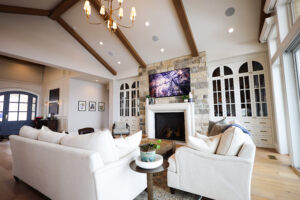Are you tired of squinting at your favorite show on a small TV screen? Do you want a theater-like experience right in the comfort of your own home? Then, it’s time to consider investing in a home theater. But with so many options available, it can be overwhelming to make a decision between a traditional TV screen and a projector. So, which should you choose? In this blog post, we’ll break down the pros and cons of both home theater projectors and TV screens to help you determine which one is best suited for your entertainment needs.
Overview of Home Theater Projectors
A projector works by shining a light through a small transparent lens to project an image onto a large screen. The technology used in projectors can vary, but the most common types include Liquid Crystal Display (LCD) and Digital Light Processing (DLP). LCD projectors use three glass panels, one each for the image’s red, blue, and green components. As light passes through these panels, small pixels open or close to create the image. On the other hand, DLP projectors use tiny mirrors that tilt towards or away from the light source to create the image.
Projectors are a popular choice for home theater systems because of the cinematic experience they offer. A projector’s large screen size is one of its most significant advantages over a traditional TV. This can make you feel like you’re in a real movie theater. We will focus on two main types of projectors going forward: long throw and short throw.
Long Throw Projectors
Long-throw projectors are the most common type of home theater projector. They are designed to be placed far from the screen or wall they are projecting onto, typically between 10-15 feet away. This means you need a room with enough space for the projector to be mounted on a ceiling or placed on a table at the back of the room.
Long-throw projectors are often more affordable than short-throw projectors, making them a popular choice for home theaters on a budget. However, the downside is that you may need to invest in additional equipment and installation costs to set up a long-throw projector properly in your home.
Short Throw Projectors
Short-throw projectors are becoming increasingly popular in home theaters due to their compact size and ability to project large images from shorter distances. These projectors can be mounted on the wall or placed on a shelf just a few feet away from the screen or wall they are projecting onto. This makes them ideal for smaller home theaters.
One interesting idea is to set up a short-throw projector in a custom cabinet at the front of the room. The projector is placed inside the cabinet and projects the image upward directly onto the screen. This is ideal for theater rooms that are short on space or that double as a living room.
There is also an option to have motorized projector screens that can go up and down as needed. This lets you display artwork or decorations on the wall when you’re not using the screen, making the space look even more appealing. This would not be possible with the use of a TV.
Understanding TV Screens for Home Theaters
TV screens have evolved and improved over the years, making them popular for home theater planning. However, this has led to some confusion about the different types of TV screens available on the market. Here are some standard terms you may come across when researching TVs for your home theater:
- LCD (Liquid Crystal Display): This type of screen uses a backlight to project an image onto the screen. It’s known for its bright and vibrant colors.
- LED (Light-Emitting Diode): These screens use an array of LEDs as a backlight, resulting in better contrast and brightness than LCD screens.
- OLED (Organic Light-Emitting Diode): Unlike LCD and LED screens, OLED screens do not have a backlight. Instead, each pixel emits its own light, making for deeper blacks and better color accuracy.
- QLED (Quantum-dot Light-Emitting Diode): This newer technology uses a layer of quantum dots to enhance color and brightness on an LED screen.
- HDR (High Dynamic Range): This refers to the range of colors and contrast a TV can display. HDR TVs can show a wider range of colors, producing more realistic and vibrant images.
TVs have a certain appeal in home theater setups primarily due to their ease of installation and operation. Unlike projectors, which require careful placement, screen alignment, and room conditions, TVs offer a plug-and-play convenience. Once the TV is securely mounted or placed, you only need to connect it to a power source, and it’s ready to use.
Additionally, TVs offer reliable picture quality regardless of room lighting conditions, unlike projectors, which typically require a darkened environment for optimal viewing. However, the size and resolution of TVs may limit your viewing experience, especially if you have a large room or prefer a more immersive display.
How to Choose a TV or Projector for Your Home Theater
Now that we’ve discussed the differences between TVs and projectors, let’s explore some factors to consider when choosing the correct display for your home theater.
Viewing Distance
The correct viewing distance is critical for a comfortable and enjoyable viewing experience. Professionals can determine the optimal viewing distance based on seat distance and design. Sitting too close can cause eye strain while sitting too far can make images appear smaller.
- TVs: Ideal for smaller rooms or spaces with limited viewing distance. For example, a large screen size may not be necessary if you have a living room with a seating area directly in front of the TV.
- Projectors: Better suited for larger rooms or setups where you can create ample distance between the projector and screen/wall. This allows for a wider screen size and a more immersive viewing experience.
Screen Size
- TVs: Typically range from 32 to 80 inches, with larger sizes becoming more prevalent in recent years. Consider the size of your room and viewing distance when choosing a TV screen size.
- Projectors: Can display image sizes anywhere from 60 to 100+ inches, giving you more options for creating a cinematic experience. Keep in mind that the size of your room and the projector’s throw distance will also affect the screen size.
Resolution
- TVs: There are a variety of different options for TV resolution, all with varying price points. 4K Ultra HD TVs provide the highest resolution, four times better than full high definition (HD). This technology offers more pixels that help to create beautiful colors and pristine image quality.
- Projectors: Also offer a range of resolutions, with some new models supporting 4K. However, keep in mind that projector resolution can be affected by external factors such as ambient light or screen material.
Brightness
- TVs: The enhanced refresh rate and pixel density of modern TVs enable stunning color, while HDR technology offers increased brightness to give you a more detailed picture.
- Projectors: The brightness of a projector is measured in lumens, with higher numbers indicating a brighter image. For home use, look for projectors with at least 2,000 lumens. However, the brightness of a projector can decrease over time, so it’s important to consider the lamp’s life and replacement costs.
Installation
- TVs: These are typically mounted on a wall or placed on a stand, making them easy to set up and install. The convenience of this simple setup is a major selling point for many people.
- Projectors: Ceiling mounting may require professional installation and wiring. The projector screen will also need to be installed, and the projector will need to be aligned and calibrated for optimal image quality.
Smart Technology
- TVs: Many modern TVs come with built-in streaming capabilities, allowing you to access popular streaming services such as Netflix, Hulu, and Amazon Prime Video directly from your TV.
- Projectors: Some projectors also offer smart features and streaming capabilities but may not be as robust as those found in TVs. Our recommendation is a product like Kaleidescape, which can be added to your projector setup and delivers the best home movie-watching experience.
Price
- TVs: Prices for TVs can vary greatly depending on size, brand, and features. Generally, larger and higher-end models will be more expensive. It’s important to set a budget and research different options before making a purchase.
- Projectors: Projectors can also vary in price depending on the resolution, brightness, and other features. However, keep in mind that additional costs may be incurred for installation and maintenance.
Product Recommendations from AIS
With technological advancements, both TVs and projectors continue to improve, providing consumers with a range of options for their home entertainment needs.
If you have decided on a projector setup, we recommend investing in a great 4k projector from Sony. These projectors offer stunning picture quality, high contrast, and vibrant colors. For screens, we highly recommend Screen Innovations to provide the highest quality visual to pair with a Sony projector.
For those looking for a TV option, we suggest checking out OLED TVs from brands like LG, Samsung, or Sony. These TVs offer exceptional picture quality with deep blacks and rich colors. They also have built-in smart features and streaming capabilities for a seamless viewing experience.
Ultimately, deciding between a TV or projector will come down to personal preference, budget, and room setup. Both options provide excellent home entertainment experiences, so it’s important to do thorough research and consult with experts before purchasing.
Let AIS Help Choose the Best Display For Your Home Theater
It can be easy to get caught up in the excitement of the latest and greatest technology. As we’ve discussed, there are many factors to consider when deciding between a TV screen or a home theater projector. It ultimately comes down to how much enjoyment it brings you and your loved ones. Whether you’re a cinephile or a casual user, investing in a quality home entertainment system can transform your movie nights and game days into unforgettable experiences. Still have questions or want a professional opinion? Contact us today for a consultation, or use our budget calculator to plan expenses.
Frequently Asked Questions
Is a projector or TV better for small rooms?
TVs are usually the best choice for smaller spaces since they deliver consistent picture quality at closer viewing distances without requiring additional equipment or installation. Projectors typically work better in larger rooms where you can create enough distance for a big-screen effect.
Do projectors need a completely dark room to work well?
Not necessarily. While projectors perform best in darker environments, many modern projectors have high brightness levels (measured in lumens) that make them usable even in rooms with some ambient light. Still, for the most cinematic results, a dim or dark space is ideal.
Which option is more cost-effective: a TV or a projector?
It depends on your setup. TVs may have a higher upfront cost for large screens, but they require little to no extra installation. Projectors can be more affordable for big screen sizes, but you’ll need to factor in costs for mounting, screens, and potential lamp replacements.
Can I get smart features with a projector like I can with a TV?
Yes, but with some limitations. While many TVs come with built-in streaming apps, some projectors may require add-ons like streaming sticks or systems such as Kaleidescape to access the same features. This gives you flexibility but may add to the total investment.



